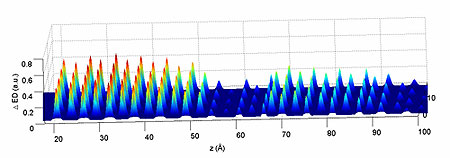
1st Atomic-scale QD Map Made
The first atomic-scale maps of quantum dots have been created by a team of physicists at the University of Michigan, who say it is a major step toward producing “designer dots” that can be tailored for specific applications.
Quantum dots – often called artificial atoms or nanoparticles – are tiny semiconductor crystals with wide-ranging potential applications in computing, photovoltaic cells, light-emitting devices and other technologies. Each dot is a well-ordered cluster of atoms, 10 to 50 atoms in diameter.
Engineers are gaining the ability to manipulate the atoms in quantum dots to control their properties and behavior, through a process called directed assembly. But until now, progress has been slowed by the lack of atomic-scale information about the structure and chemical makeup of quantum dots.

In this atomic-scale map of the interface between an atomic dot and its substrate, each peak represents a single atom. The map, made with high-intensity x-rays, is a slice through a vertical cross section of the dot. (Image: University of Michigan)
The new atomic-scale maps will help fill that knowledge gap, clearing the path to more rapid progress in the field of quantum-dot directed assembly, said Roy Clarke, professor of physics and corresponding author of a paper on the topic published online Sept. 27 in the journal Nature Nanotechnology.
Lead author is Divine Kumah of the university’s applied physics program, who conducted the research for his doctoral dissertation.
“I liken it to exploration in the olden days,” Clarke said of dot mapping. “You find a new continent, and initially all you see is the vague outline of something through the mist. Then you land on it and go into the interior and really map it out, square inch by square inch.
“Researchers have been able to chart the outline of these quantum dots for quite a while. But this is the first time that anybody has been able to map them at the atomic level, to go in and see where the atoms are positioned, as well as their chemical composition. It’s a very significant breakthrough.”
To create the maps, Clarke’s team illuminated the dots with a brilliant x-ray photon beam at Argonne National Laboratory’s Advanced Photon Source. The beam acts as an x-ray microscope to reveal details about the quantum dot’s structure. Because x-rays have very short wavelengths, they can be used to create superhigh-resolution maps.
“We’re measuring the position and the chemical makeup of individual pieces of a quantum dot at a resolution of one-hundredth of a nanometer,” Clarke said. “So it’s incredibly high resolution.”
A nanometer is one-billionth of a meter.
The availability of atomic-scale maps will quicken progress in the field of directed assembly. That, in turn, will lead to new technologies based on quantum dots. The dots have already been used to make highly efficient lasers and sensors, and they might help make quantum computers a reality, Clarke said.
“Atomic-scale mapping provides information that is essential if you’re going to have controlled fabrication of quantum dots,” said Clarke. “To make dots with a specific set of characteristics or a certain behavior, you have to know where everything is, so that you can place the atoms optimally. Knowing what you’ve got is the most important thing of all.”
In addition to Clarke, co-authors are Sergey Shusterman, Yossi Paltiel and Yizhak Yacoby.
The research was sponsored by a grant from the National Science Foundation. The US Department of Energy supported work at Argonne National Laboratory’s Advanced Photon Source.
For more information, visit: www.umich.edu
Published: September 2009